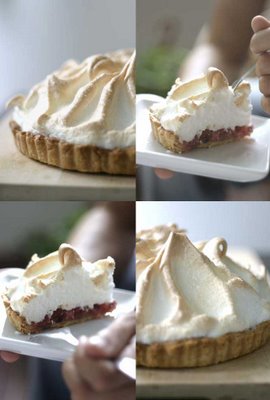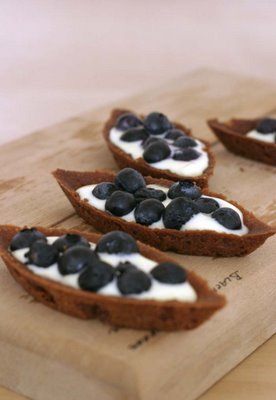Organic Gems
In a recent bid to eat healthier, I finally gave in to my better (financial) judgement and decided to go organic (well, as organic as I can afford and is possible here, that is). My friend put me in touch with Elena from Red Gum Organics and now, every Thursday, a boxful of organic fruit and vegetables arrives at my door. Besides the known and obvious benefits of organic produce — no pesticides, no steriods, etc, etc, etc — going organic in this manner essentially forces one to find creative ways to cook whatever's at your door before they expire. Before you know it, you've also reached more than your usual daily quota of fruit and fibre.
Another upside to this arrangement is that Elena imports her produce from Australia, which means very often her list will include fruit and veg uncommon to Singapore, including jerusalem artichoke, passionfruit and rhubarb. These I buy up with glee, mostly because it forces me to rifle through my cookbooks and attempt recipes I normally wouldn't.

When it comes to finding recipes for rhubarb, one name on my bookshelf springs to mind. Nigella Lawson is the queen of bright and splashy produce. Stumped for ideas with clementines, pomegranate, peas or watermelon? The domestic goddess herself has them all in her books—if only, I suspect, so she can wax lyrical about their "gorgeous colours" and refer to them as "jewels" or "gems".

Anyway, with my stash of beautiful organic rhubarb, I made a Rhubarb Meringue Pie from Nigella's How To Eat. If you're going to attempt this in an 8-inch pan as Ms Lawson suggests, then I suggest you halve the quantity of the rhubarb and egg filling mix. The 650g of rhubarb was enough to fill two pies, which actually, was a good thing, because the recipe leaves out cooking temperatures for the filling and the meringue top. The only temperature instruction in that recipe appears when she calls for you to preheat the oven to 200 degrees for the pastry.
Essentially, you bake the pie shell blind and when it is cool, fill it with the rhubarb, egg and sugar mixture and bake till that is set. Then you whisk the egg whites with sugar and cream of tartare to make your meringue and bake that. Now, if you bake everything at a steady 200 degrees Celsius, what you'll get is pastry that is one minute from burnt and a bronze meringue that slices to a runny, watery inside that tastes of uncooked eggwhites. At least that's what I got even though I turned down the heat to 180 degrees when cooking the meringue and filling. Luckily there was still enough rhubard mix to fill another pie, so the next day, I tried again.
The pastry is dead easy to make — in fact, Nigella's recipe for pastry is quite foolproof. Measure out butter and flour in a bowl and freeze it for 20 minutes before blitzing in a food processor and binding with a bit of liquid. I got excellent, easy-to-handle flaky pastry every time. This time I baked the rhubarb mix at 180 degrees and the meringue top at 160 degrees. The results were far better. Even my cat, Flash, agrees.

Another upside to this arrangement is that Elena imports her produce from Australia, which means very often her list will include fruit and veg uncommon to Singapore, including jerusalem artichoke, passionfruit and rhubarb. These I buy up with glee, mostly because it forces me to rifle through my cookbooks and attempt recipes I normally wouldn't.

When it comes to finding recipes for rhubarb, one name on my bookshelf springs to mind. Nigella Lawson is the queen of bright and splashy produce. Stumped for ideas with clementines, pomegranate, peas or watermelon? The domestic goddess herself has them all in her books—if only, I suspect, so she can wax lyrical about their "gorgeous colours" and refer to them as "jewels" or "gems".

Anyway, with my stash of beautiful organic rhubarb, I made a Rhubarb Meringue Pie from Nigella's How To Eat. If you're going to attempt this in an 8-inch pan as Ms Lawson suggests, then I suggest you halve the quantity of the rhubarb and egg filling mix. The 650g of rhubarb was enough to fill two pies, which actually, was a good thing, because the recipe leaves out cooking temperatures for the filling and the meringue top. The only temperature instruction in that recipe appears when she calls for you to preheat the oven to 200 degrees for the pastry.
Essentially, you bake the pie shell blind and when it is cool, fill it with the rhubarb, egg and sugar mixture and bake till that is set. Then you whisk the egg whites with sugar and cream of tartare to make your meringue and bake that. Now, if you bake everything at a steady 200 degrees Celsius, what you'll get is pastry that is one minute from burnt and a bronze meringue that slices to a runny, watery inside that tastes of uncooked eggwhites. At least that's what I got even though I turned down the heat to 180 degrees when cooking the meringue and filling. Luckily there was still enough rhubard mix to fill another pie, so the next day, I tried again.
The pastry is dead easy to make — in fact, Nigella's recipe for pastry is quite foolproof. Measure out butter and flour in a bowl and freeze it for 20 minutes before blitzing in a food processor and binding with a bit of liquid. I got excellent, easy-to-handle flaky pastry every time. This time I baked the rhubarb mix at 180 degrees and the meringue top at 160 degrees. The results were far better. Even my cat, Flash, agrees.





